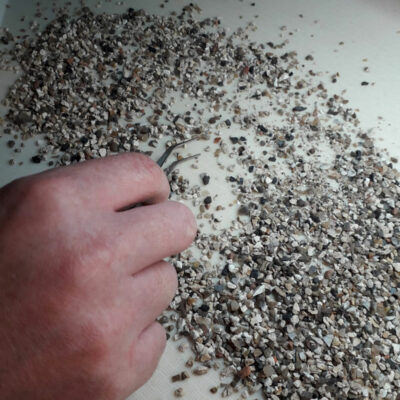Palaeoenvironmental Assessment
What is palaeoenvironmental processing, assessment and analysis?
Palaeoenvironmental processing is the washing of soil samples to separate microscopic material that cannot be retrieved during excavation. Once processed from the soil, this microscopic material can be assessed for a quick indication of potential or it can be fully analysed for comprehensive reporting of the palaeoenvironmental record.
The microscopic material takes the form of:
Botanical material such as charred plant remains (CPR) or waterlogged, mineralised or otherwise preserved uncharred archaeobotanics. Botanical material is analysed by our in-house archaeobotanists and identified to inform on past diets, economies and the surrounding environment. Charcoal is an important subset of the botanical material and is analysed by our in-house anthracologists to inform on past wood/fuel use and woodland/environment management for domestic or industrial purposes. Anthracological analysis of charcoal from cremations can indicate the wood selection for pyres and is important information for our osteologists.
Artefactual material that is too small to have been recovered in the field. This frequently comprises personal items such as beads, dice and brooches/pins. Any artefactual material is passed to our in-house Finds specialists.
Faunal (bone) material that is too small to have been recovered in the field. The inclusion of bones from smaller animals within the site assemblage helps inform on the environment in which people were living. For example, were their houses infested with mice or were toads living in their damp boundary ditches. Faunal material is passed to our in-house archaeozoologists.
Molluscan material (shells) from terrestrial snails is identified by our in-house archaeomalacologists to inform on the environment in which the snails lived and, consequently, the environment for the human inhabitants.
Microscopic slag (microslag) is an important inclusion in the archaeometallurgical assemblage of a site as it can be used to indicate the type of metalworking undertaken nearby.
Why us?
We are one of the largest processors of palaeoenvironmental samples in the UK.
We have a purpose-built flotation facility in Milton Keynes and Leominster, specifically designed and managed to examine environmental material unearthed during fieldwork projects, including large-scale open-area archaeological excavations. Our in-house facility ensures high professional standards and timely sampling, processing, analysis and report writing in line with developer programme delivery.
Link to view video
What Happens Next?
Our highly experienced Team of Environmental Scientists, Archaeobotanists, Osteologists, Anthracologists, Pottery, Coin and Leather Specialists contribute essential data to reports for the discharge of archaeological Planning Conditions.












